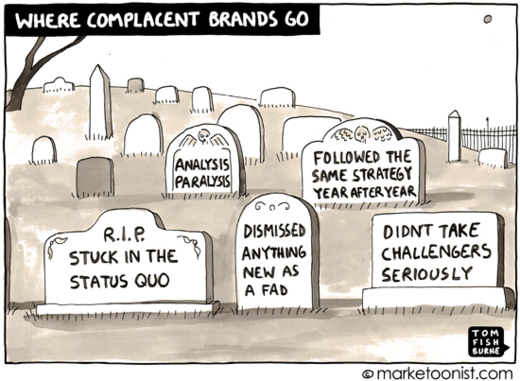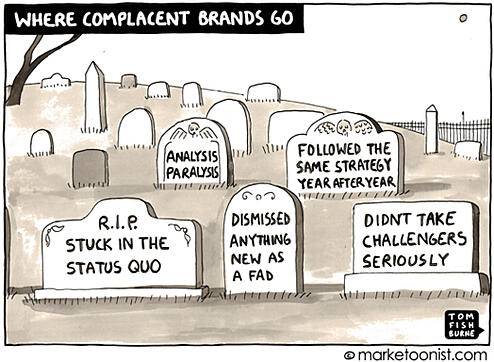Complacency is something that can rear its ugly head in any organization that doesn’t build the culture and mechanisms to keep it at bay. A feeling of satisfaction of being “good enough” can creep into any organization after a period of success or the achievement of a specific goal. At Rhythm Systems, we work with clients every day to make sure that they are successful and constantly challenging the status quo and putting mechanisms in place for continual improvement.
http://tomfishburne.com/2013/03/where-complacent-brands-go.html
There are a few key things that you can do in order to make sure that your organization is structured to battle complacency:
- Update goals: People like to have goals to work towards and love healthy competition to liven up the workplace. They like to face a challenge and come out on top; it is part of our competitive nature. The trick is to make sure that you are constantly updating your goals, while sticking to your core values. Make sure that when you are planning the party for the successful completion of the goal that you have new goals waiting in the wings to keep your team constantly focused on becoming better. Different types of goals also keep it interesting, so if you just reached a key financial objective you can mix it up a bit and have the next goal concentrate on customer satisfaction or another important initiative.
- Comfort is not the objective: Companies need to stimulate and support a culture that embraces constant change and improvement before the market demands it. You need to have an environment where it is okay to fail as long as you were acting in the best interest of the company. If you do not have the culture that allows for failure, employees aren’t going to stretch themselves as they don’t want to get their head “whacked” for trying something that didn’t work out. If taking calculated risks isn’t part of your culture, you are less likely to create a new breakthrough that could take your company to the next level. If someone takes a risk and it doesn’t succeed, make sure that you encourage the employee even if you have to shelve the project.
- Create organizational instruments of discomfort: In order to keep your team reaching for the stars, you need to have internal mechanisms to create a measure of discontent that challenges the company to evolve. In Jim Collins’ Built to Last he describes how General Electric created a method called “work out.” Groups of employees met to discuss new opportunities, or what Rhythm Systems calls winning moves, and made product or project proposals. Upper managers were not allowed to participate in the discussion, but they had to make decisions on the spot. They weren’t afforded the time to procrastinate or dodge a decision entirely, they were expected to give feedback immediately. Not only does this help speed up decision-making and risk taking, it also develops leaders and talent in your organization.
- Always invest in the future: Visionary companies know that they don’t necessarily need to choose between short-term performance and long-term success. They build first and foremost for the long-term health of the company and its core values, while simultaneously holding themselves and their teams to high standards in the short-term. Great companies continue to invest heavily in the future even when there is an economic downturn. It could be a blessing in disguise that you are able to hire key “A” players in the industry that you might not have otherwise been able to hire during peak economic periods. Perhaps you can use this time to have “skunk works” projects that can develop new winning moves, open new markets and increase enthusiasm in the company.
These tips will help you take the next step in your company to create the long lasting mechanisms that encourage growth and stimulate new ideas. Once the culture is created to support constant improvement your company, you will begin to notice a positive culture change with more engaged employees that have a new sense of purpose with improved involvement in the future growth strategy of the company.
Photo Credit: iStock by Getty Images



 LinkedIn
LinkedIn
 Facebook
Facebook
